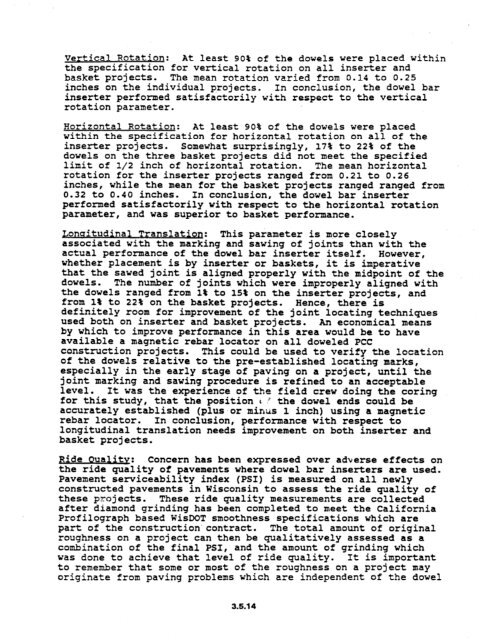chapter 3 rigid pavement - DOT On-Line Publications - Department ...
chapter 3 rigid pavement - DOT On-Line Publications - Department ...
chapter 3 rigid pavement - DOT On-Line Publications - Department ...
Create successful ePaper yourself
Turn your PDF publications into a flip-book with our unique Google optimized e-Paper software.
Vertical Rotation: At least 90% of the dowels were placed within<br />
the specification for vertical rotation on all inserter and<br />
basket projects. The mean rotation varied from 0.14 to 0.25<br />
inches on the individual p,rojects. In conclusion, the dowel bar<br />
inserter performed satisfactorily with respect to the vertical<br />
rotation parameter.<br />
Horizontal Rotation: At least 90% of the dowels were placed<br />
within the specification for horizontal rotation on all of the<br />
inserter projects. Somewhat surprisingly, 17% to 22% of the<br />
dowels on the three basket projects did not meet the specified<br />
limit of I/2 inch of horizontal rotation. The mean horizontal<br />
rotation for the inserter projects ranged from 0.21 to 0.26<br />
inches, while the mean for the basket projects ranged ranged from<br />
0.32 to 0.40 inches. In conclusion, the dowel bar inserter<br />
performed satisfactorily with respect to the horizontal rotation<br />
parameter, and was superior to basket performance.<br />
Lonaitudinal Translation- This parameter is mpre closely<br />
associated with the marking and sawing of joints than with the<br />
actual performance of the dowel bar inserter itself. However,<br />
whether placement is by inserter or baskets, it is imperative<br />
that the sawed joint is aligned properly with the midpoint of the<br />
dowels. The number of joints which were improperly aligned with<br />
the dowels ranged from 1% to 15% on the inserter projects, and<br />
from 1% to 22% on the basket projects. Hence, there is<br />
definitely room for improvement of the joint locating techniques<br />
used both on inserter and basket projects. An economical means<br />
by which to improve performance in this area would be to have<br />
available a magnetic rebar locator on all doweled FCC<br />
construction projects. This could be used to verify the location<br />
of the dowels relative to the pre-established locating marks,<br />
especially in the early stage of paving on a project, until the<br />
joint marking and sawing procedure is refined to an acceptable<br />
level. It was the experience of t? re field crew doing the coring<br />
for this study,<br />
that the position L ? the dowel ends could be<br />
accurately established (plus,or minus 1 inch) using a magnetic<br />
rebar locator. In conclusion, performance with respect to<br />
longitudinal translation needs improvement on both inserter and<br />
basket projects.<br />
Ride Quality: Concern has been expressed over adverse effects on<br />
the ride quality of <strong>pavement</strong>s where dowel bar inserters are used.<br />
Pavement serviceability index (PSI) is measured on all newly<br />
constructed <strong>pavement</strong>s in Wisconsin to assess the ride quality of<br />
these projects. These ride quality measurements are collected<br />
after diamond grinding has been completed to meet the California<br />
Profilograph based Wis<strong>DOT</strong> smoothness specifications which are<br />
part of the construction‘contract. The total amount of original<br />
roughness on a project can then be qualitatively assessed as a<br />
combination of the final PSI, and the amount of grinding which<br />
was done to achieve that level of ride quality. It is important<br />
to remember that some or most of the roughness on a project may<br />
originate from paving problems which are independent of the dowel<br />
3.5.14
















